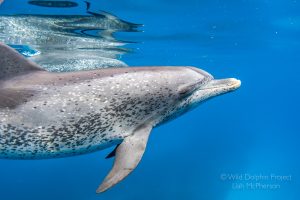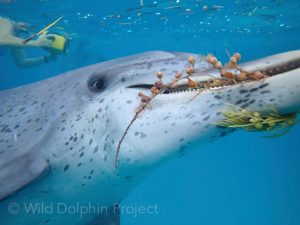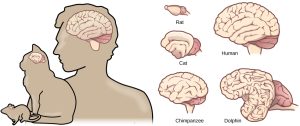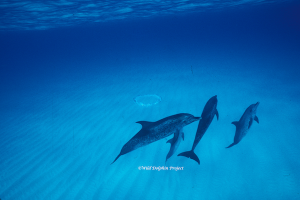Are dolphins smart? It’s a question we hear often. But what does it mean to be intelligent, and how can we measure sure it?

Understanding animal cognition — the mental abilities of non-human animals – is a broad and complicated field. Generally, intelligence can be defined ability to learn and apply knowledge; to understand new or challenging situations and the ability to think abstractly. “Dolphins demonstrate the ability to do all of these things and most scientists agree that dolphins are very intelligent. They are notoriously talented mimics and quick learners; they demonstrate self-awareness, problem-solving, and empathy, innovation, teaching skills, grief, joy and playfulness,” according to Whale and Dolphin Conservation USA.
We certainly see evidence of intelligence in the dolphins we study in the Bahamas, from their natural curiosity, social interactions and willingness to mimic us humans. They’ve even taught US how to play seaweed games with them, which is pretty impressive.

As humans, we tend to think of and measure animal intelligence as it compares to humans. But more and more, scientists are asking questions about how animals reveal their own unique smarts and abilities.
Mirror, Mirror
One way scientists measure intelligence is through the mirror self-recognition (MSR) test. It’s a is a behavioral technique developed in 1970 by American psychologist Gordon Gallup Jr. as an attempt to determine whether an animal possesses the ability of visual self-recognition. If they do, that means they likely have self-awareness,
For the MSR test, an animal is anesthetized and then marked with paint or sticker on an area of the body the animal normally cannot see. Once the animal wakes up, they are given access to a mirror and if they touch or investigate the marked region, it indicates that the animal realizes the reflection is their own, rather than another animal.
Not many animals have passed the mirror test, but a few include Asian elephants, the great apes including Bonobos, chimpanzees, orangutans, and gorillas, bottlenose dolphins, orcas, magpies, manta rays, and most recently — a mouse, as well as a few others.
One study involved the famous orca Tilikum -a 12-foot long male captured from Icelandic waters- who was repeatedly observed sticking his tongue out at his reflection after being marked with non-toxic paint during testing sessions at SeaWorld Orlando.
Lots of animals have repeatedly failed, including various species of macaques, baboons, and octopus. Humans being to self-recognize in a mirror around 18–30 months old, for comparison.
The test isn’t without criticism, however. It’s limited to species that primarily rely on visual cues. For instance, dogs have been shown to recognize their own scent but have failed the MSR test. It also relies on an animal being motivated to investigate the mark.

The hamadryas baboon is one primate species that fails the mirror test.
Big Brains
Whales and dolphins have big brains, especially when compared to body mass — something known as the encephalization quotient. Bottlenose dolphin brains weigh about 1600 grams, which makes dolphins second only to humans in brain-to-body weight ratio. In fact, their brains are about 4 or 5 times larger than would be expected for their body size when compared to another animal of similar size.

According to researcher Hans Thewissen, a professor at Northeast Ohio Medical University who has studied cetacean evolution, ancestors of modern dolphins first began to evolve a large brain size in the ancestors of all whales and dolphins in the Eocene Epoch that ended about 33 million years ago. Another jump happened again in the early delphinids, the ancestors of modern dolphins, porpoises and belugas, about 27 million years ago.
A large brain doesn’t necessarily mean more smarts. But, some research shows that species with brains that are large relative to their bodies are more intelligent when their problem-solving skills were tested.
Whale and dolphin brains also contain specialized brain cells called spindle neurons, previously only known to be in humans and primates. These are associated with advanced abilities such as recognizing, remembering, reasoning, communicating, perceiving, adapting to change, problem-solving and understanding — even feeling love, intuition and suffering emotionally, based on where these cells occur in the brain. So far, they’ve been found in humpback whales, fin whales, killer whales and sperm whales.
“It’s absolutely clear to me that these are extremely intelligent animals,” Patrick Hof of the Mount Sinai School of Medicine in New York said in a statement. He is the co-discoverer of the whale spindle cells.
Research also shows that brain size in mammals has increased following natural disasters, such as the extinction of the dinosaurs 66 million years ago. Experts think this could be due to the fact many mammals found new habitats to live in that were previously occupied by dinosaurs, often requiring new adaptations in either brain or body size (read more).
Tool Use and Cooperation
Dolphins and whales, particularly orcas and bottlenose dolphins have evolved many different techniques for for feeding, often cooperating within a group and taking on different roles.
In Shark Bay, Australia, for instance, local bottlenose dolphins use tools, according to scientists who study them. One group, called spongers, grab a sea sponge and dive down to the grassy seafloor and poke them into the sandy seabed. This disturbs the hiding fish for the dolphins to snatch up, while also protecting their noses from scuffs, scraps, or even stings from stingrays. Other dolphins grab conch shells and bring them to the surface. They shake the shell to drain the water and then flick out any remaining trapped fish. Each of these techniques is passed down from dolphin to dolphin.

A female bottlenose dolphin with a marine sponge tool in Shark Bay, Western Australia. https://sharkresearch.earth.miami.edu/age-specific-foraging-performance-and-reproduction-in-tool-using-wild-bottlenose-dolphins/
In Florida, dolphins circle schools of fish in shallow water, beating their tails to stir up the mud that essentially traps the fish. In parts of the Carolinas and Georgia, dolphins use the shore to trap fish. They create a wave pushing the fish onto the shore, then snatch up the beached fish. Orcas work together in Norway to herd schools of herring or create waves to make seals on ice floats in Antarctica fall into the water. When humpback whales create bubble rings to trap fish, each individual has a different role. Some are bubble-blowers, others dive deep to ensure the fish are driven upwards, and some make calls to help herd the prey.
Complicated Chatter
At the Wild Dolphin Project, Denise Herzing, Ph.D., founder and director, specializes in studying communication and behavior. She knows a lot about their vocalizations, like the fact that make sounds 10 times as high and hear sounds 10 times as high as humans do.

But they have other communication signals they use. “They have good vision, so they use body postures to communicate. They have taste not smell, and they have touch. And sound can actually be felt in the water because the acoustic impedance of tissue in water is about the same, so dolphins can buzz and tickle each other at a distance,” she said.
We know that dolphins have unique, whistles for individuals, called signature whistles, which functions like a name. Infant dolphins learn their names (individual whistles) from their mothers and keep them for life. Dolphins greet one another at sea by exchanging their names and seem to remember the names of other dolphins for decades, according to Whale and Dolphin Conservation USA.
In captivity, dolphins can learn symbols created by humans and sentences, and sentence structure. They know that ‘bring the hoop to the ball’ is different from ‘bring the ball to the hoop,’ according neuroscientist Lori Marino, the president of The Whale Sanctuary Project, who has studied dolphin brains and intelligence for 30 years.
Herzing has teamed up with computer scientists to use machine-learning in an attempt to not only understand more about WILD dolphin communication and whether or not they have their own language, but also try to communicate with the dolphins. This work holds the ability to “bridge the gap” and transcend the artificial boundaries between non-human animals and humans with the establishment of a mutually comprehensive communication system. Read more here.
“They have culture, they use tools, they have complex societies,” said Marino. “These animals are very much like us because of their social complexities, their behavior, their level of self-awareness.”
What do you think, are dolphins and whales intelligent?
Read more:
NPR, Mirror, Mirror, On The Wall: Can You Reveal An Animal’s Inner World At All?
New Atlas, Mouse passes mirror test, joining elite club of ‘self-aware’ animals
